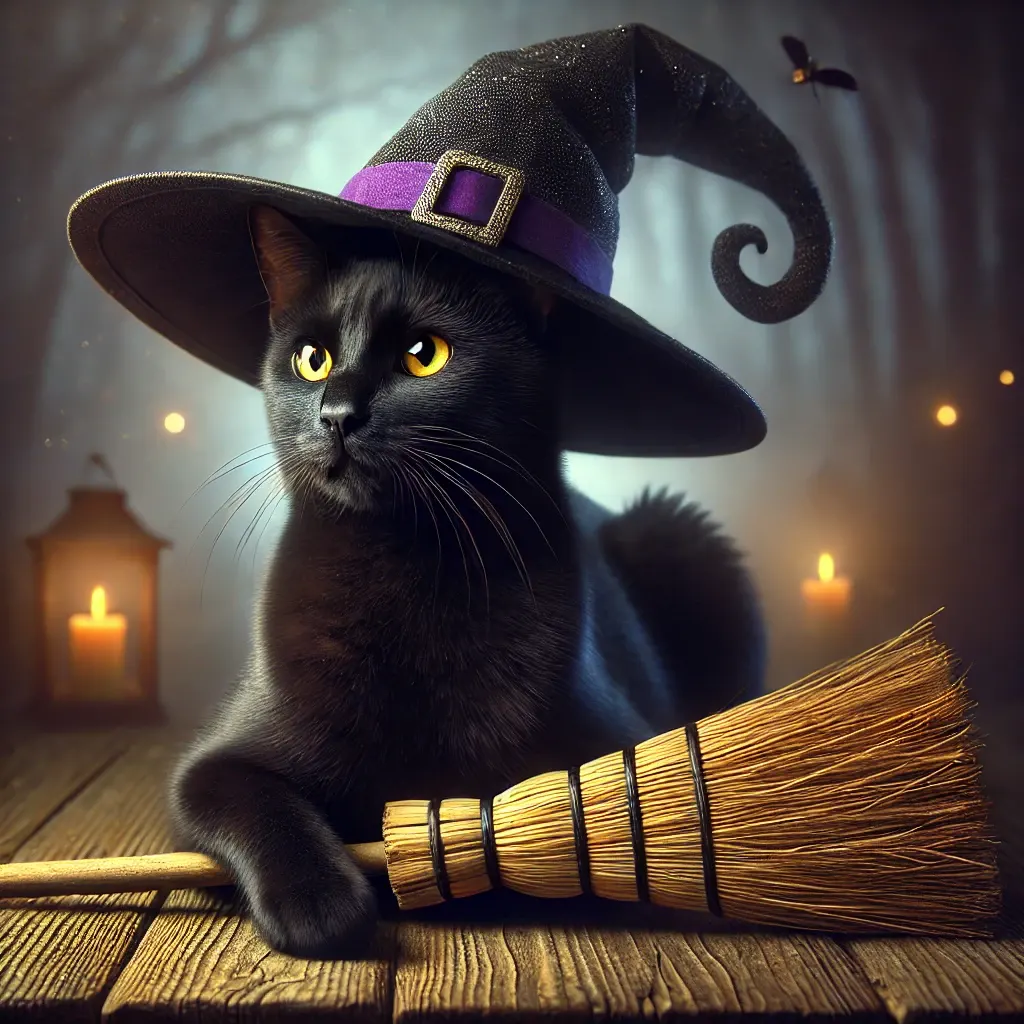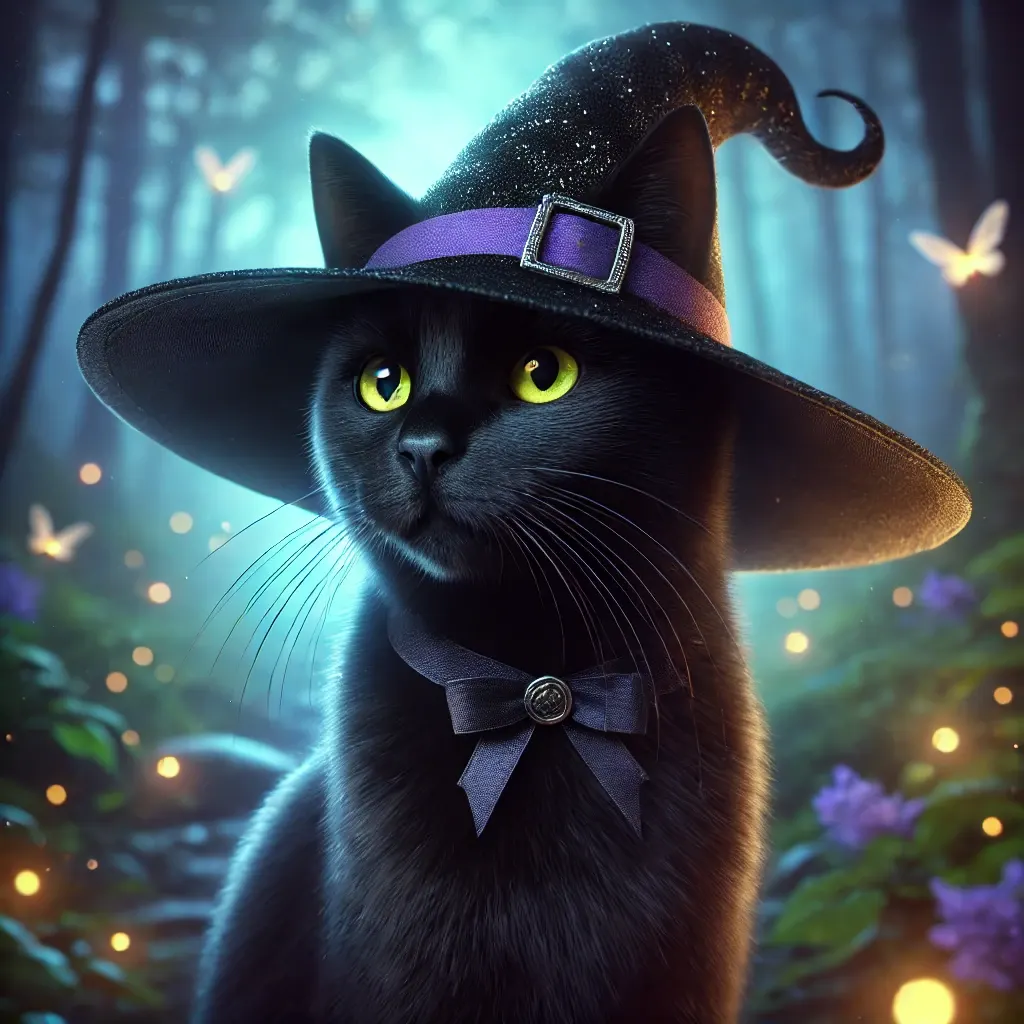Black cats have been the subject of myths, legends, and superstitions throughout history. Their figure has been surrounded by mystery, fear, fascination, and, in many cases, persecution. From adoration in Ancient Egypt to their connection with witches in the Middle Ages, black cats have been seen as symbols of good luck, embodiments of the devil, and companions of witches.
Although today black cats are admired for their elegance and charm, their reputation has gone through centuries of controversy and misunderstandings. This article explores the complete history of the myths, legends, and superstitions about black cats, with a special emphasis on their relationship with witches and their impact on modern culture.
1. Black Cats in Antiquity
1.1. Black Cats in Ancient Egypt (3100 B.C. – 30 B.C.)
In Ancient Egypt, cats, regardless of their color, were considered sacred and protectors of the home. They were revered for their association with the goddess Bastet, the deity of protection, fertility, and harmony in the home. Bastet was represented as a woman with the head of a cat, and the presence of cats in homes was believed to protect families from evil spirits and diseases.
- Fun fact: Black cats were not seen negatively. In fact, harming a cat, even accidentally, was punishable by death. Cats were even mummified after their death, and their owners mourned their loss with great sorrow.
1.2. Black Cats in Norse Mythology (8th – 11th Century)
In Norse mythology, cats were also highly regarded. Cats were linked to the goddess Freyja, the deity of love, fertility, and magic. According to legend, Freyja traveled in a chariot pulled by two large black cats. This connection made cats respected, revered, and associated with prosperity and fertility.
2. Black Cats and Their Relationship with Witches
2.1. Black Cats as Witches’ Familiars
In medieval Europe, especially during the Middle Ages, the belief that black cats were “familiars” of witches became widespread. Familiars were magical creatures, usually animals, that assisted witches in performing magic. Cats, due to their stealthy and nocturnal nature, were seen as ideal “familiars.”
- Transformation of witches into cats: It was believed that witches could transform into black cats to avoid detection. This belief became popular in England and Scotland, where people believed that if someone saw a black cat at night, they might be seeing a witch in disguise.

2.2. The Papal Bull “Vox in Rama” (1232)
In 1232, Pope Gregory IX issued the papal bull “Vox in Rama”, a document that explicitly linked black cats to the devil. This decree accused heretics of worshiping the devil in the form of a black cat during their ceremonies. This statement generated collective fear and triggered the hunting and killing of black cats, as they were seen as embodiments of evil.
2.3. The Persecution of Black Cats During the Witch Hunts (14th – 17th Century)
During the witch hunts, black cats were not only persecuted, but they were also burned along with accused witches. In many executions of women accused of witchcraft, their cats were burned with them as a symbol of purifying evil.
- The Salem Witch Trials (1692-1693): In New England, women accused of witchcraft were often identified as guilty simply for having black cats as pets. This association alone was enough for them to be accused of witchcraft. The cats were often executed alongside their owners.

3. Superstitions About Black Cats
3.1. Black Cats and Bad Luck
In England, Scotland, and America, a superstition emerged stating that if a black cat crosses your path, it brings bad luck. This belief was carried to the American colonies, especially to New England, by European settlers.
3.2. Symbols of Good Luck in Other Cultures
While black cats have been seen as omens of bad luck in some cultures, in other parts of the world, they are seen as symbols of good fortune and prosperity.
- Japan: Black cats are believed to protect against evil spirits and are considered symbols of prosperity.
- United Kingdom: In certain regions of England, it is believed that seeing a black cat cross your path brings good luck.
- Russia: In Russia, black cats are not associated with bad luck and are welcomed into homes as good omens.
4. Black Cats in Modern Culture
4.1. Black Cats in Literature
In 1843, Edgar Allan Poe published his short story “The Black Cat”, a psychological horror story that symbolizes guilt, madness, and remorse. This story solidified the image of black cats as omens of death.
4.2. Black Cats and Halloween
During Halloween, the image of the black cat has become an iconic symbol. Their image, along with witches and pumpkins, is present in decorations and costumes. This relationship stems from their association with witches and the occult.
4.3. International Black Cat Day (October 27)
International Black Cat Day is celebrated every October 27. The purpose of this day is to combat superstitions and promote the adoption of black cats, as these animals are often the last to be adopted due to historical and cultural prejudices.
5. Benefits and Curiosities About Black Cats
- Their fur changes color in the sun: Prolonged exposure to the sun can cause the fur of black cats to take on a dark brown tone due to the effects of melanin.
- Not all black cats are completely black: Many black cats have hidden white patches on their bellies or paws.
- The Bombay cat: This breed was developed to look like a mini black panther, with glossy black fur and striking copper-colored eyes.
- Adoption difficulties: Black cats face more difficulty being adopted due to historical prejudices and superstitions.
6. Conclusion
Black cats have transitioned from being sacred symbols in Egypt to being viewed as witches’ familiars during the Middle Ages. Their connection with magic, witchcraft, and superstition has given them an ambiguous reputation. In some cultures, black cats are symbols of good luck, while in others, they are seen as omens of bad luck.
Today, black cats face less discrimination, but they are still among the last to be adopted in shelters. The International Black Cat Day seeks to reclaim their value and demystify their image.
These felines, who were once persecuted and burned along with witches, are now adored as loyal and charismatic companions. Their elegance and mystery have made them enduring symbols of gothic culture, mystery, and Halloween.
